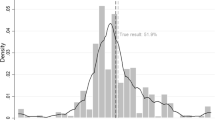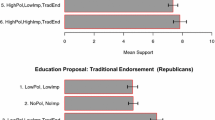Abstract
Numerous representation studies suggest that political elites are responsive to the expressed preferences of their voters, but scholars in the field have called for experimental research on the topic to shed light on the underlying mechanisms. This paper responds to this call. Results from a survey experiment with members of parliament in Belgium show, for the first time, that an important mechanism driving responsiveness is opinion adaptation by political elites. Just like ‘ordinary’ citizens adapt their opinions when learning where their preferred party stands on an issue, politicians update their position when learning that it opposes the preferences of a majority of their electorate. This implies that elite responsiveness involves less discord between politicians’ own preferences and voter preferences than is often assumed.





Similar content being viewed by others
Data availability
The data were collected in the framework of the POLPOP project. POLPOP is a transnational project examining the perceptual accuracy of politicians in four countries. It was initiated by Stefaan Walgrave from the University of Antwerp (Flanders, Belgium). Flemish funding comes from the national science foundation (FWO) with grant number G012517N. The following people were part of the Flemish POLPOP team: Stefaan Walgrave, Julie Sevenans, Pauline Ketelaars, Karolin Soontjens, Kirsten Van Camp and Arno Jansen.
Notes
Note that there is some ambiguity in the literature about how ‘responsiveness’ and ‘congruence’ are conceptualized and measured (for an extensive discussion, see Beyer and Hänni 2018). In line with most of the literature, we see responsiveness as a dynamic, causal process where politicians bring their behavior closer to what the majority of the voters wants. Ideally, they end up in line with the preferences of this majority, hence establishing congruence.
The first path represents how constituencies exert control by electing elites who share their preferences—which we labeled ‘representation through correct voting’ above. The arrows corresponding to this path (starting with an arrow from voter’s attitude to representative’s attitude) are not shown in Fig. 1.
The files for replication are published on Dataverse: https://dataverse.harvard.edu/dataset.xhtml?persistentId=doi:10.7910/DVN/RTUBVV
A balance test confirms that the randomization succeeded on characteristics like gender, age, parliamentary experience, party and parliament (regional/federal); see Online Appendix 2.
We asked politicians to judge two additional scenarios (about how they would communicate towards a journalist and a voter respectively), but as these items do not deal with how politicians represent voters substantively they are not discussed here.
Note that these differences are not related to our experimental manipulation: the party position estimations of the treatment group are not significantly higher (nor lower) than the estimations of the control group (t = -.52; p = .603).
Calculated via the medeff command in Stata.
References
Adams, J., Clark, M., Ezrow, L., & Glasgow, G. (2004). Understanding change and stability in party ideologies: Do parties respond to public opinion or to past election results? British Journal of Political Science, 34(4), 589–610
Arceneaux, K., Dunaway, J., & Soroka, S. (2018). Elites Are people, too: The effects of threat sensitivity on policymakers’ spending priorities. PLoS ONE, 13(4), e0193781
Arnold, C., Sapir, E. V., & de Vries, C. E. (2012). Parties’ positions on European integration: Issue congruence, ideology or context? West European Politics, 35(6), 1341–1362
Bafumi, J., & Herron, M. C. (2010). Leapfrog representation and extremism: A study of American voters and their members in congress. American Political Science Review, 104(3), 519–542
Belchior, A. M. (2014). Explaining MPs’ perceptions of voters’ positions in a party-mediated representation system: Evidence from the Portuguese case. Party Politics, 20(3), 403–415
Beyer, D., & Hänni, M. (2018). Two sides of the same coin? Congruence and responsiveness as representative democracy’s currencies. Policy Studies Journal, 46(S1), S13-47
Blumer, H. (1948). Public opinion and public opinion polling. American Sociological Review, 13(5), 542–549
Brack, N., Costa, O., & Teixeira, C. P. (2012). Attitudes towards the focus and style of political representation among Belgian, French and Portuguese parliamentarians. Representation, 48(4), 387–402
Broockman, D. E., & Butler, D. M. (2017). The causal effects of elite position-taking on voter attitudes: Field experiments with elite communication. American Journal of Political Science, 61(1), 208–221
Butler, D. M., & Dynes, A. M. (2016). How politicians discount the opinions of constituents with whom they disagree. American Journal of Political Science, 60(4), 975–989
Butler, D. M., Naurin, E., & Öhberg, P. (2016). Party representatives’ adaptation to election results: Dyadic responsiveness revisited. Comparative Political Studies.
Butler, D. M., & Nickerson, D. W. (2011). Can learning constituency opinion affect how legislators vote? Results from a field experiment. Quarterly Journal of Political Science, 6(1), 55–83
Canes-Wrone, B., Brady, D. W., & Cogan, J. F. (2002). Out of step, out of office: Electoral accountability and house members’ voting. American Political Science Review, 96(1), 127–140
Cayton, A. F. (2017). Consistency versus responsiveness: Do members of congress change positions on specific issues in response to their districts? Political Research Quarterly, 70(1), 3–18
Cohen, G. L. (2003). Party over policy: The dominating impact of group influence on political beliefs. Journal of Personality and Social Psychology, 85(5), 808–822
Cooper, J., & Fazio, R. H. (1984). A new look at dissonance theory. In L. Berkowitz (Ed.), Advances in experimental social psychology. (pp. 229–266). Academic Press.
Dahl, R. A. (1956). 115 a preface to democratic theory. University of Chicago Press.
Depauw, S. (2003). Part 2: Discipline: Government party discipline in parliamentary democracies: The cases of Belgium, France and the United Kingdom in the 1990s. The Journal of Legislative Studies, 9(4), 130–146
Druckman, J. N., & Jacobs, L. R. (2006). Lumpers and splitters. The public opinion information that politicians collect and use. Public Opinion Quarterly, 70(4), 453–476
Eisinger, R. M. (2003). The evolution of presidential polling. Cambridge University Press.
Eulau, H., & Karps, P. D. (1977). The puzzle of representation: Specifying components of responsiveness. Legislative Studies Quarterly, 2(3), 233–254
Ezrow, L., de Vries, C. E., Steenbergen, M., & Edwards, E. (2011). Mean voter representation and partisan constituency representation: Do parties respond to the mean voter position or to their supporters? Party Politics, 17(3), 275–301
Gabel, M., & Scheve, K. (2007). Estimating the effect of elite communications on public opinion using instrumental variables. American Journal of Political Science, 51(4), 1013–1028
Geer, J. G. (1996). From tea leaves to opinion polls: A theory of democratic leadership. Columbia University Press.
Grose, C. R., Malhotra, N., & Van Houweling, R. (2015). Explaining explanations: how legislators explain their policy positions and how citizens react. American Journal of Political Science, 59(3), 724–743
Hakhverdian, A. (2012). The causal flow between public opinion and policy: Government responsiveness, leadership, or counter movement? West European Politics, 35(6), 1386–1406
Harteveld, E., Kokkonen, A., & Dahlberg, S. (2017). Adapting to party lines: The effect of party affiliation on attitudes to immigration. West European Politics, 40(6), 1177–1197
Hill, K. Q., & Hurley, P. A. (1999). Dyadic representation reappraised. American Journal of Political Science, 43(1), 109–137
Kingdon, J. W. (1973). Congressmen’s voting decisions. Harper & Row.
Kuklinski, J. H. (1978). Representativeness and elections: A policy analysis. The American Political Science Review, 72(1), 165–177
Kuklinski, J. H., & Elling, R. C. (1977). Representational role, constituency opinion, and legislative roll-call behavior. American Journal of Political Science, 21(1), 135–147
Lau, R. R., & Redlawsk, D. P. (1997). Voting correctly. American Political Science Review, 91(3), 585–598
Lax, J. R., & Phillips, J. H. (2009). Gay rights in the states: Public opinion and policy responsiveness. American Political Science Review, 103(3), 367–386
Lax, J. R., & Phillips, J. H. (2012). The democratic deficit in the states. American Journal of Political Science, 56(1), 148–166
Lenz, G. S. (2009). Learning and opinion change, not priming: Reconsidering the priming hypothesis. American Journal of Political Science, 53(4), 821–837
Mansbridge, J. (2003). Rethinking representation. American Political Science Review, 97(4), 515–528
McDermott, R. (2002). Experimental methods in political science. Annual Review of Political Science, 5(1), 31–61
Miller, W. E. (1999). Policy representation in Western Democracies. Oxford University Press.
Miller, W. E., & Stokes, D. E. (1963). Constituency influence in congress. The American Political Science Review, 57(1), 45–56
Önnudóttir, E. H. (2014). Policy congruence and style of representation: Party voters and political parties. West European Politics, 37(3), 538–563
Page, B. I., & Shapiro, R. Y. (1983). Effects of public opinion on policy. American Political Science Review, 77(1), 175–190
Poole, K. T. (2007). Changing minds? Not in congress! Public Choice, 131(3), 435–451
Sheffer, L., Loewen, P. J., Soroka, S., Walgrave, S., & Sheafer, T. (2018). Nonrepresentative representatives: An experimental study of the decision making of elected politicians. American Political Science Review, 112(2), 302–321
Slothuus, R. (2016). Assessing the influence of political parties on public opinion: The challenge from pretreatment effects. Political Communication, 33(2), 302–327
Soroka, S. N., & Wlezien, C. (2005). Opinion-policy dynamics: Public preferences and public expenditure in the United Kingdom. British Journal of Political Science, 35(04), 665–689
Soroka, S. N., & Wlezien, C. (2010). Degrees of democracy: Politics, public opinion and policy. Cambridge University Press.
Stimson, J. A., Mackuen, M. B., & Erikson, R. S. (1995). Dynamic representation. American Political Science Review, 89(3), 543–565
Tajfel, H. (1982). Social psychology of intergroup relations. Annual Review of Psychology, 33(1), 1–39
Uslaner, E. M. (1999). The movers and the shirkers. University of Michigan Press.
Vanknippenberg, D., & Wilke, H. (1992). Prototypicality of arguments and conformity to ingroup norms. European Journal of Social Psychology, 22(2), 141–155
Weissberg, R. (1978). Collective vs. dyadic representation in congress. American Political Science Review, 72(2), 535–547
Wlezien, C. (2004). Patterns of representation: Dynamics of public preferences and policy. Journal of Politics, 66(1), 1–24
Wlezien, C. (2017). Public opinion and policy representation: On conceptualization, measurement, and interpretation. Policy Studies Journal, 45(4), 561–582
Wlezien, C., and Soroka, S. N. (2016). Public opinion and public policy. Oxford research encyclopedia of politics. Retrieved Mar 27, 2019 from http://oxfordre.com/view/https://doi.org/10.1093/acrefore/9780190228637.001.0001/acrefore-9780190228637-e-74.
Wood, W. (2000). Attitude change: Persuasion and social influence. Annual Review of Psychology, 51(1), 539–570
Wouters, R., & Walgrave, S. (2017). Demonstrating power: How protest persuades political representatives. American Sociological Review, 82(2), 361–383
Zaller, J. (1990). Political awareness, elite opinion leadership, and the mass survey response. Social Cognition, 8(1), 125–153
Acknowledgements
I would like to thank the members of M2P (University of Antwerp) and Stuart Soroka (University of Michigan) for their useful comments on earlier versions of the paper.
Funding
While conducting this research, the author was a postdoctoral researcher of the FWO (Fonds voor Wetenschappelijk Onderzoek Vlaanderen) in research group M2P (Media, Movements & Politics) at the University of Antwerp (Belgium). Grantee number: 12X6218N.
Author information
Authors and Affiliations
Corresponding author
Ethics declarations
Conflict of interest
There are no conflicts of interests.
Replication
The material for replication is published on Dataverse: https://dataverse.harvard.edu/dataset.xhtml?persistentId=doi:10.7910/DVN/RTUBVV.
Additional information
Publisher's Note
Springer Nature remains neutral with regard to jurisdictional claims in published maps and institutional affiliations.
Supplementary Information
Below is the link to the electronic supplementary material.
Rights and permissions
About this article
Cite this article
Sevenans, J. How Public Opinion Information Changes Politicians’ Opinions and Behavior. Polit Behav 43, 1801–1823 (2021). https://doi.org/10.1007/s11109-021-09715-9
Accepted:
Published:
Issue Date:
DOI: https://doi.org/10.1007/s11109-021-09715-9




